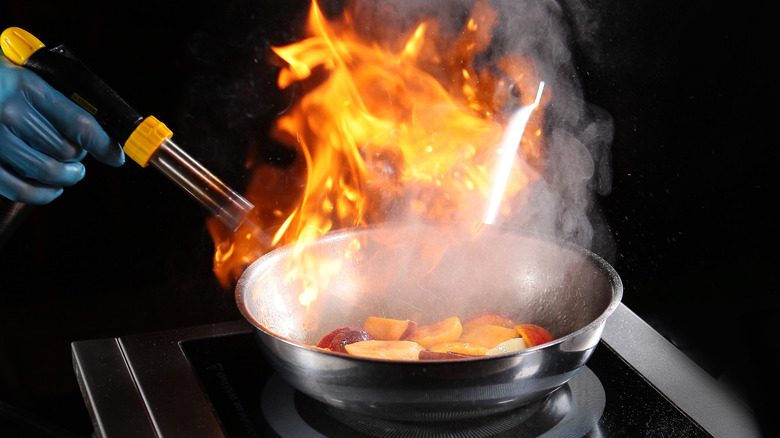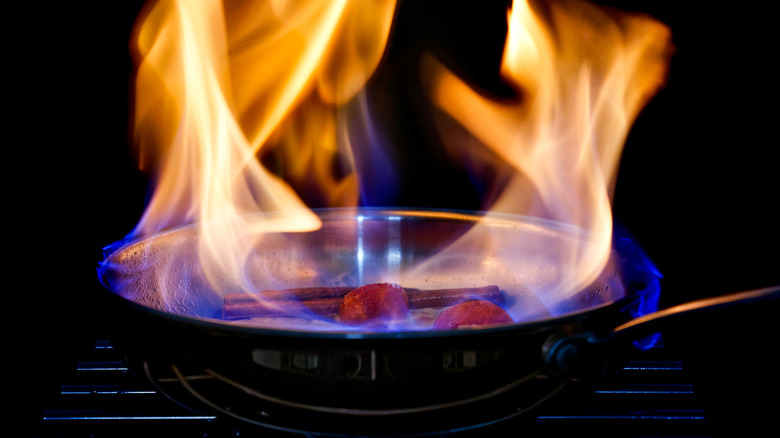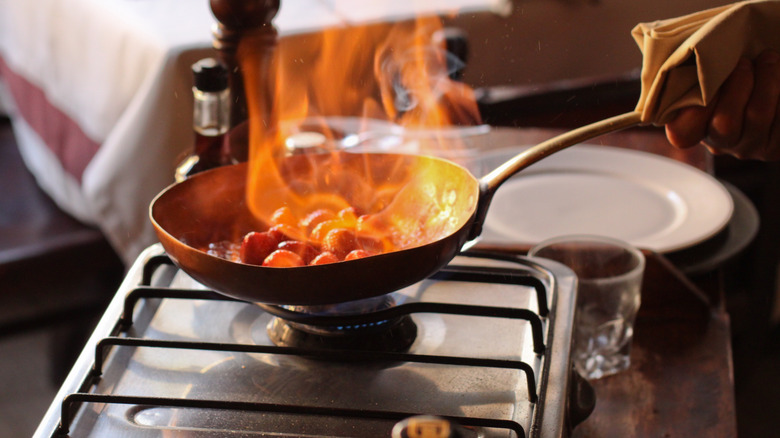Think Beyond Bananas The Next Time You Flambe Fruit
Flambe is a sight to behold. All you have to do is douse a dish in booze — and, with the flick of a (long-reach) lighter, a simple meal becomes a sizzling spectacle, coating the food in fire and flavor. Whether you're scouring menus for ignited items or tackling the technique at home, though, your dish of choice may likely involve bananas. After all, bananas Foster is probably the most well-known of the flambeed desserts. It was invented at Brennan's restaurant in New Orleans as a flamboyant way to enjoy the fruit (of which they use an absurd amount annually). It became a classic, the go-to dish when you want to (intentionally) set food on fire. With such an ostentatious technique, it would be a shame to only use bananas. And Chef Cédric Vongerichten, executive chef and owner of Wayan and host of City Harvest 2024, says that you don't have to.
Bananas aren't the only fruit that stands up well to being splashed with alcohol and set aflame. For fruit flambe, Vongerichten also likes peaches, apples, pineapples, or pears — fruits with a wide range of flavor potential. "They have natural sweetness," Vongerichten told Food Republic, "that caramelizes nicely, and they hold up well to the cooking process without becoming too mushy."
A little amaretto gives pears a caramel taste; apples pair with apple brandy or even Fireball for a cinnamon punch. Pineapples and peaches both go hand-in-hand with rum. And you can't go wrong with the bananas Foster treatment: serving on ice cream.
Other good choices for flambe
These two factors — sweetness and texture — are crucial when you're veering away from the proverbial bananas Foster to flambe other fruits. When flambeing fruit, you'll coat the fruit in a caramel made of butter and sugar before igniting. You need fruit with a subtle sweetness and tang, which can also be found in fruits like pineapples and apples, that won't overwhelm the palate; a firm and not overripe texture is also necessary to endure the flames.
And although bananas Foster firmly established flambe for dessert, it isn't only the dessert that is worth setting alight. Vongerichten had another suggestion: "crepes Suzette [is] great for flambeing." But Vongerichten encourages your flambe exploration to go even further than the traditional sweet recipes — "Unique options can be flambeing seafood, like shrimp or scallops, or some vegetables, like mushrooms."
It's worth it to expand your flambe repertoire because the technique isn't only about the aesthetics. Flambe will undoubtedly add a delicious drama to your dinner party, but it also delivers on flavor.
The purpose of flambe (other than a good show)
Sure, the primary appeal of flambeing your food is probably in its spectacle, but the bright flames aren't all the technique has to offer. The array of fruits, vegetables, meats, and seafood will also get the added benefit of flavor. Alcohol alone can be a little intense on the tongue, but the fire burns that harshness off and all that's left is the more delicate flavors of the booze — like the orange in Grand Marnier or the spice of rum. That does mean that you have to choose your booze wisely. In a basic way, you'll need a liquor that's fairly high in alcohol content, around 40% ABV or 80 proof, for the right amount of flame, but beyond that, the choice of the best liquor to flambe food is in the taste that will best complement your dish.
You'll also find that the ignition gives off a smoky flavor and makes the taste of the ingredients more intense. It doesn't flame long, only really a few seconds, so you don't have to worry about burning or overcooking. So pick a new fruit or seafood (or just stick with the classics) and flambe away.



